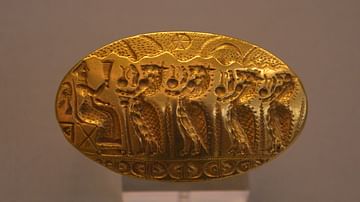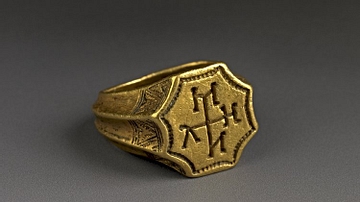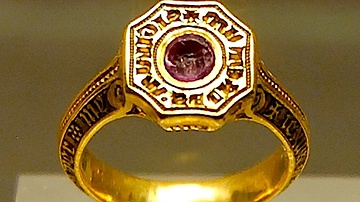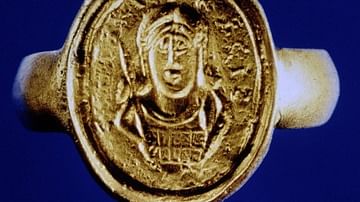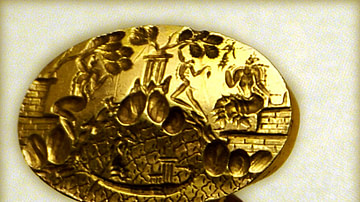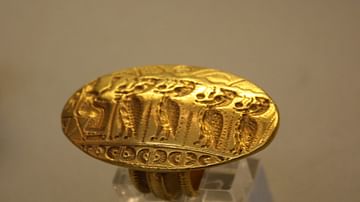Illustration
Gold signet ring showing one female and two male figures before a temple, from Phourni, Crete, c. 1700-1450 BCE.
Heraklion Archaeological Museum, Crete.
Minoan religion is characterized by the prominent role of female figures engaged in ritual activities. These figures are depicted performing ritual gestures such as raising their arms, holding snakes, sticks, or double-headed axes, dancing with one hand on the waist and the other raised above their heads, or making offerings and libations. These figures, often interpreted as goddesses, priestesses, or even political leaders, are frequently shown with symbolic animals and objects sacred in Minoan culture, such as bees, cranes, palm trees, and discs, which may represent the sun.
Another important category of Minoan artifacts closely associated with religious practices is signet rings made from precious metals, particularly gold. Several examples can be viewed today at the Heraklion Archaeological Museum in Crete. One such example features a central female figure flanked by two male figures: one kneeling with arms inclined in his front – another ritual gesture in Minoan art – and the other performing the oklasma, a gesture in which fingers are interlocked above the head to produce a snapping sound. This gesture later became part of the dance routine in Dionysiac scenes. In the background, a temple made of simple mudbrick is shown, a common architectural feature used by the Minoans to enclose sacred natural objects, such as a rock or, as seen in this case, a tree.
About the Author
Cite This Work
APA Style
Choubineh, N. (2025, January 08). Minoan Gold Signet Ring with Three Figures before a Temple. World History Encyclopedia. Retrieved from https://www.worldhistory.org/image/19833/minoan-gold-signet-ring-with-three-figures-before/
Chicago Style
Choubineh, Nathalie. "Minoan Gold Signet Ring with Three Figures before a Temple." World History Encyclopedia. Last modified January 08, 2025. https://www.worldhistory.org/image/19833/minoan-gold-signet-ring-with-three-figures-before/.
MLA Style
Choubineh, Nathalie. "Minoan Gold Signet Ring with Three Figures before a Temple." World History Encyclopedia. World History Encyclopedia, 08 Jan 2025, https://www.worldhistory.org/image/19833/minoan-gold-signet-ring-with-three-figures-before/. Web. 07 May 2025.



